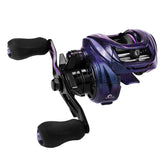
How to: Crappie Fishing during the Winter
Fishing for Crappie in the winter is a unique challenge. Like many fish, there are certainly different techniques that can be used to maximize your opportunity to catch fish when you are targeting crappie in the winter. Let's start with the basics and move to more advance techniques that have worked for me in the past.
Gear
One of the first things we need to understand is that most fish are more picky and finicky in cold water. Since crappie are particularly small fish, you can really step down your gear to provide more life-like action in the baits you are using and the feel of the strikes.
In order to really get a good feeling I suggest using UL gear rated 2-6 lbs like the KastKing Zephyr line of spinning reels and rods. If you are finding that the standard line is still too heavy or not working for you, try the ice fishing reels that provide a nice finesse feel to your casting. I load 4lbs mono on my tiny 500 size spinning reel and use jigs that are 1/32 to 1/16 oz. If you need to long cast, you can step up the reel to a 1000 and with a light enough line or finesse braid you can get that silky smooth cast that will get to where the fish are. If you need to get it out even further, using a longer rod always helps as well. For me, I fish under docks and in pretty close to shore so just use a tiny 5' rod to assure I get where I need to go. I am always a believer that a short rod will give more accuracy while a long rod will give more distance. Naturally, this varies greatly on the angler but as a general rule of thumb, this is what I use.

If you are a more experienced angler and enjoy using baitcasters over spinning reels, the new KastKing Kestrel has a shallow spool and is made for throwing small bait and working a more finesse type of fishing style with slower reeling and more subtle action on the rod. I have my Kestrel loaded with 6lbs braid and tipped with 4 lbs mono just to cut down on the visability a touch more.
Environment
Fishing in the winter comes with a reliable assumption that the water and the weather is just colder. This means that fish will move slower and just be overall less likely to be swimming around freely. This leaves the entire challenge of winter fishing to be finding them. To do so, we rely on a few things. Look for structure, particularly with rocks, stone or concrete. Why? These types of material tend to hold heat longer and insects and bait fish prefer to dwell around those areas. This means that the crappie that see these creatures as food are more likely to be there as well. If you are not lucky enough to find any cover with stone, go with any other kind of brush or cover. This can be grass or fallen trees or maybe even trash in the water. Again, we are looking for where bait is hiding and where the crappie might be looking for their next meal. Winter fishing for most species starts with an understanding of energy and availability. When the water is colder the fish are just more lethargic and do not want to move and spend the energy to chase their meals. By knowing this we can capitalize on matching the hatch of the bait that is around in this time of the year.
Bait
I mentioned before that using lighter gear in the winter is always recommended, additionally I mentioned that crappie really do not want to move much and are not chasing the larger bait in the water. By knowing this we can then go in the opposite direction to gain the appeal of the fish by scaling down the bait we are using and thus, the size of the line and gear we are fishing with. My all time favorite type of bait when fishing crappie are the little 1/16 soft plastic swim jigs. You want to keep the bait in the middle of the column and work it with slow pulsing motion and letting the bait drop then pull it back up to work the entire water column where the fish may be waiting. If this is not working after trying different colors and action, I change my rig to a small version of a texas rig with 1/16 - 1/8oz bullet shaped head and small worm with a tail. The tail helps slow down the plastic and provides more action to encourage a strike. Lastly, some bait hanging from a bobber may prove to be an option but I would really consider this a last resort. The challenge here is to not only find the fish but to also know the depth the fish are at. I have had success using meal worms and Berkley crappie bites but you must cover the hook well. I can only assume that crappie are just more finicky and are quick to reject anything that looks odd to them like part of a hook.
Winter fishing has a higher learning curve than most other fishing. Keeping your tempo slower and pay attention to where you are getting strikes is the key. Observing and continued learning from time on the water will serve you well. Hopefully this helped some of you in enjoying fishing all year round.













